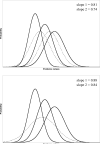Signal detection with criterion noise: applications to recognition memory
- PMID: 19159149
- PMCID: PMC2862236
- DOI: 10.1037/a0014351
Signal detection with criterion noise: applications to recognition memory
Abstract
A tacit but fundamental assumption of the theory of signal detection is that criterion placement is a noise-free process. This article challenges that assumption on theoretical and empirical grounds and presents the noisy decision theory of signal detection (ND-TSD). Generalized equations for the isosensitivity function and for measures of discrimination incorporating criterion variability are derived, and the model's relationship with extant models of decision making in discrimination tasks is examined. An experiment evaluating recognition memory for ensembles of word stimuli revealed that criterion noise is not trivial in magnitude and contributes substantially to variance in the slope of the isosensitivity function. The authors discuss how ND-TSD can help explain a number of current and historical puzzles in recognition memory, including the inconsistent relationship between manipulations of learning and the isosensitivity function's slope, the lack of invariance of the slope with manipulations of bias or payoffs, the effects of aging on the decision-making process in recognition, and the nature of responding in remember-know decision tasks. ND-TSD poses novel, theoretically meaningful constraints on theories of recognition and decision making more generally, and provides a mechanism for rapprochement between theories of decision making that employ deterministic response rules and those that postulate probabilistic response rules.
Figures









References
-
- Aggleton JP, Shaw C. Amnesia and recognition memory: A re-analysis of psychometric data. Neuropsychologia. 1996;34:51–62. - PubMed
-
- Akaike H. Information theory and an extension of the maximum likelihood principle. In: Petrov BN, Csaki F, editors. Second international symposium on information theory. Akademiai Kiado; Budapest: 1973. pp. 267–281.
-
- Ashby FG, Maddox WT. Relations between prototype, exemplar, and decision bound models of categorization. Journal of Mathematical Psychology. 1993;37:372–400.
-
- Atkinson RC, Carterette EC, Kinchla RA. The effect of information feedback upon psychophysical judgments. Psychonomic Science. 1964;1:83–84.

